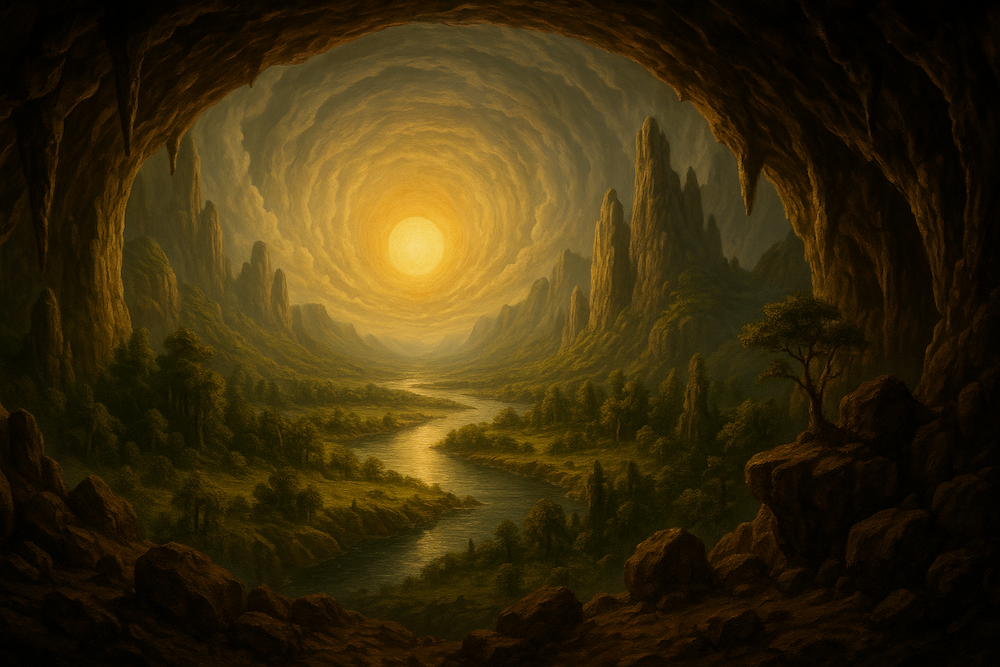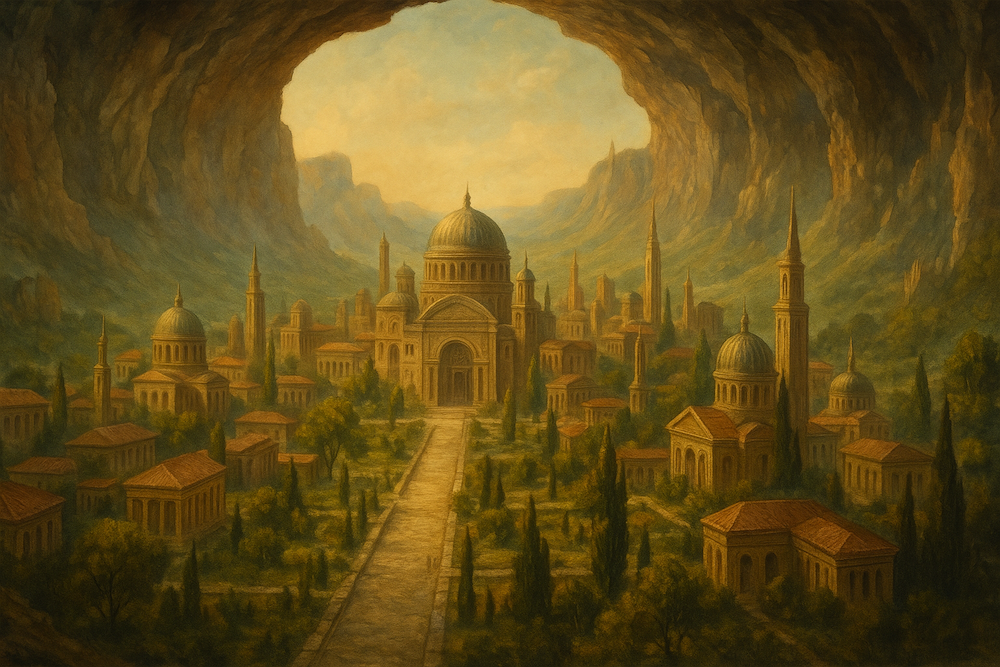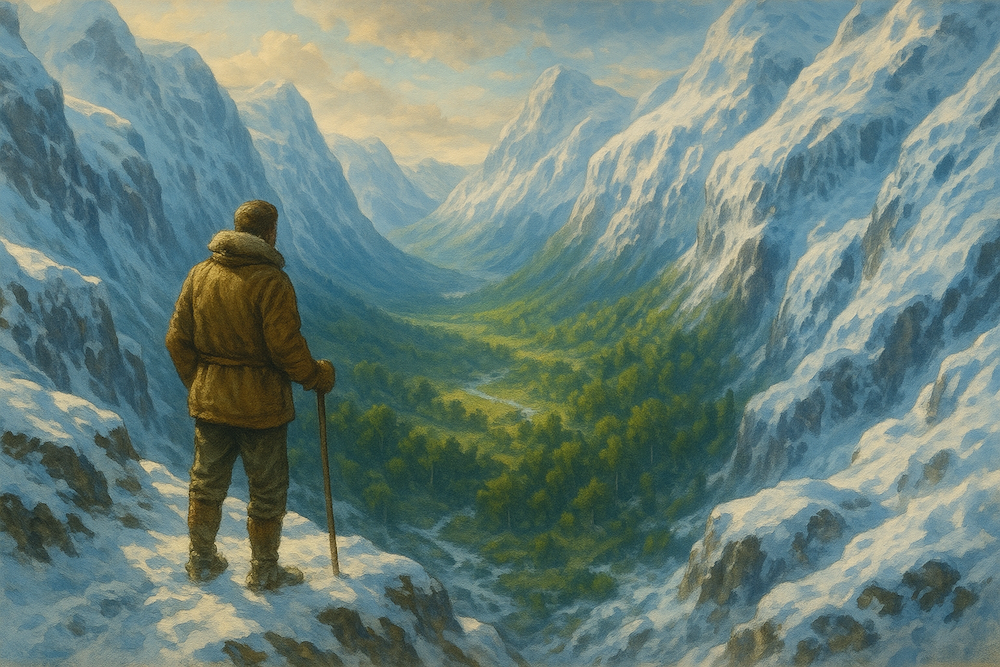From scientific speculation to conspiracy theories, looking into the interesting history of one of the most popular alternative worldviews among people
TL;DR: The Hollow Earth theory has changed from a real scientific idea in the 17th century to a modern conspiracy theory. Seismic evidence, gravitational measurements, and our understanding of how planets form have all completely disproven it, but it still fascinates people with stories of underground civilizations, Nazi expeditions, and Admiral Byrd's controversial missions to Antarctica. This lasting appeal says as much about how people think and how much we need mystery as it does about how the scientific method has won over guesswork.
Introduction: The Unknown Always Draws Us In
It seems impossible that there are huge areas of the Earth that we haven't explored yet, especially since satellites map every square meter of the surface and deep-sea submersibles explore the ocean's deepest trenches. The Hollow Earth theory, on the other hand, is still around, and it fascinates people who picture huge underground worlds with advanced civilizations, hiding everything from Nazi hideouts to alien bases. This enduring interest speaks to something deep in human nature: our never-ending need for mystery and our unwillingness to accept that we have fully mapped and understood our world.
The Hollow Earth theory suggests that our planet is either completely hollow or has large empty spaces inside it, often with their own sun and people who are much more advanced than those who live on the surface. In the 17th century, serious scientists started to wonder about this, and now it is one of the most popular alternative theories about how our planet is made, even though there is a lot of evidence against it.

When Hollow Earth Was Real Science: Its History
The Scientific Foundation of Edmond Halley (1692)
One of the most famous astronomers in history came up with the idea for the modern Hollow Earth theory. Edmond Halley, who discovered the famous comet that bears his name, suggested in 1692 that the Earth was made up of a hollow shell about 500 miles thick, with two inner shells that were concentric and an innermost core, all separated by atmospheres.
Halley's theory wasn't just a guess; it was an attempt to make sense of strange compass readings and changes in the magnetic field. He suggested that the space between each shell had glowing atmospheres that could support life, and that the Aurora Borealis and other natural events happened because these layers moved on their own.
At the time, this wasn't seen as fringe science, which is amazing. Halley was a well-known member of the Royal Society, and his hollow Earth model was a real attempt to explain things that were happening with the little information that was available in the late 1600s.
The End of Science
The theory started to fall apart in the next century. Pierre Bouguer first tentatively challenged it in 1740, and Charles Hutton's Schiehallion experiment around 1774 gave it a final blow. Researchers found that the Earth is almost twice as dense as Schiehallion, a mountain in the Scottish Highlands, by measuring its gravitational pull. This basically disproves any idea of large empty spaces.
The American Revival: John Cleves Symmes Jr.
The Eager Advocate
Even though there was more and more scientific evidence against it, the Hollow Earth theory got a new lease on life in early 19th-century America thanks to John Cleves Symmes Jr., a War of 1812 veteran who became one of the most famous supporters of the theory. He released Circular No. 1 in 1818, which told the world that the Earth is hollow.
Symmes made Halley's complicated multi-layered model easier to understand by saying that the Earth had huge holes at the north and south poles—"Symmes Holes"—that led to a warm, rich land "stocked with thrifty vegetables and animals if not men." He said that these holes were thousands of miles long and curved so gently that one could sail into them without noticing the change.
Symmes was very serious about his theory. "I pledge my life in support of this truth and am ready to explore the hollow," he wrote, "if the world will support and aid me in the undertaking." His passionate advocacy attracted followers and even influenced some politicians to consider funding an expedition.

Impact on Literature
Symmes never wrote a book, but many other authors did write about his ideas. In 1826, McBride wrote "Symmes' Theory of Concentric Spheres." Later, in 1878, Symmes's son Americus published "The Symmes' Theory of Concentric Spheres" to clear things up.
The theory had a big effect on literature. Some of the most famous early examples are Edgar Allan Poe's 1838 book "The Narrative of Arthur Gordon Pym of Nantucket," Jules Verne's 1864 book "Journey to the Center of the Earth," and Sir Edward Bulwer-Lytton's 1871 book "Vril: The Power of the Coming Race."
The Legendary World of Agartha
Where it came from in the East
The term and idea of Agartha first appeared in the 1870s, when French writer and colonial official Louis Jacolliot wrote about it in his book "Les fils de Dieu." Jacolliot said he had access to ancient Indian manuscripts that were 15,000 years old and talked about the rise and fall of the city of Asgartha.
Alexandre Saint-Yves d'Alveydre expanded on the idea, and Ferdynand Ossendowski's 1922 book "Beasts, Men and Gods" made it popular. This book became the most common version of the Agartha myth. The idea paints Agartha as a perfect kingdom in the middle of the Earth, where a powerful person known as the King of the World secretly controls events on the surface.
Links Between Religion and Culture
According to Hindu mythology, Agartha may be where the Nagas live. The Nagas are powerful and magical half-human, half-serpent gods who live at the lowest levels of the hollow earth. The idea is closely linked to Shambhala, which is an important part of Vajrayana Buddhism and Tibetan Kalachakra teachings.
Hindus, Buddhists, Native American tribes, Celts, and others tell similar stories about how humans came to be, mythical races, or gods living in caves far away from the world. Mythologies from all over the world have these common themes of underworld realms.
The Admiral Byrd Controversy
The Person in History
Admiral Richard E. Byrd was a real American hero and polar explorer. He was given the Medal of Honor for being the first person to fly in the Arctic, and he became the youngest admiral in the U.S. He made history in the Navy when he flew over the South Pole in 1929 at the age of 41. There is a lot of scientific evidence that backs up his real accomplishments in polar exploration.
The Fake "Secret Diary"
People who believe in Hollow Earth say that Byrd's plane was taken over while it was flying over the North Pole and landed by people from the center of the Earth in saucer-shaped planes. When he got there, he is said to have met representatives from Agartha who were worried about how people were using atomic bombs and made Byrd their ambassador.
But this story is based on fake proof. Historians have never been able to verify the "secret diary" that hollow Earth theorists often talk about. It seems to be a modern invention. The Byrd Polar and Climate Research Center says that none of the items in their collections back up these claims.
There is no historical record or reliable source that backs up the diary's existence. Furthermore, Byrd's public speeches and writings lack any references to Hollow Earth theories, thereby undermining the idea that he believed in or discovered such phenomena.
The Real Operation Highjump
The real Operation Highjump (1946–1947) was a real U.S. The Navy sent 13 ships, 33 planes, and 4,700 people on an expedition to Antarctica. It wasn't looking into Nazi hideouts or entrances to the hollow Earth; it was testing equipment in polar conditions, training staff, and setting up a research base.

Scientific Proof Against the Hollow Earth
Analysis of Seismic Waves
Seismology provides the most convincing evidence against the hollow Earth theory. Seismometers all over the world pick up seismic waves that earthquakes send through the Earth's interior. The way these waves move, bounce off of things, and bend shows that the Earth has a solid crust, a semi-fluid mantle, and a solid inner core surrounded by a liquid outer core.
If the Earth were hollow, the patterns of seismic waves would be very different from what we see now. Seismic waves take a certain amount of time to travel through and around the Earth, which is not possible in a completely hollow sphere.
S waves (shear waves) can't move through liquids, which is why we see an S-wave shadow zone about 103° away from earthquake epicenters. This shows that the outer core is liquid. P waves can move through solids and liquids, but they slow down when they hit the liquid outer core.
Evidence from Gravity
The only way to explain the pull of gravity on Earth's surface is with a spherical mass with a dense core. If the Earth were hollow, the gravitational forces would not match up with measurements taken at different points on the surface. The mass distribution needed to make the observed gravitational field strongly suggests that the Earth is solid, not hollow.
From a physics point of view, big things tend to stick together because of gravity, which makes spheres that aren't hollow. The solid spheroid is the most energetically stable shape. Regular matter can't hold up a planet-sized hollow shape against gravity.
New technology backs up the idea of a solid Earth
Modern satellites and space missions have made detailed maps of Earth's gravity. Data from satellites like the Gravity field and steady-state Ocean Circulation Explorer (GOCE) back up the idea that the Earth is a solid planet with different layers.
Seismologists look at shock waves that come from both natural earthquakes and man-made sources like explosions. The way these waves act as they pass through different materials proves that the Earth's interior is made up of concentric shells: a thin outer crust, a mantle, a liquid outer core, and a solid inner core.
The Psychology Behind Persistent Belief
Why the Hollow Earth Theory Lives On
There are many psychological and cultural reasons why the hollow Earth theory continues to exist, even though there is a lot of scientific evidence against it.
The Allure of Concealed Realms: In our charted and quantified existence, the notion of expansive uncharted territories beneath us provides a romantic reprieve. One researcher said, "In the 21st century, our planet feels trodden, long since mapped, and thereby stripped of its greatest mysteries."
Distrust of Authority: Many people who believe in the modern hollow Earth theory don't trust mainstream science or government institutions. They think the theory is hidden knowledge that "they" don't want us to know.
Spiritual Needs: Some people who believe in the hollow Earth think that there is an advanced, peaceful civilization below that could help us with our problems on the surface. Raymond Bernard, a supporter in the 1960s, wrote that this "older, wiser race may save us from our doom, stopping a future nuclear war and letting us start a New Age on Earth."
Modern Explorations and Faithful
It's amazing that belief still exists in the 21st century. Steve Currey, a Utah river guide, hired a Russian nuclear-powered icebreaker in 2007 to lead an expedition to find the polar entrance to the hollow Earth. A follow-up expedition was planned for 2022, and they wanted to stream their search live on "Hollow Earth TV."
Theologian Rodney Cluff and other modern believers say that "the shell of the Earth is about 800 miles thick, from the outside to the inner surface, with an interior sun suspended in the center." These beliefs show how strong the theory is, even though scientists have proven it wrong.
Telling the Truth from Lies
What We Really Know
The Real Structure of Earth: Seismic data show that the inner core is solid iron and nickel (about 1,220 km in radius), the outer core is liquid (about 2,300 km thick), the mantle is solid (about 2,900 km thick), and the crust is thin (5–70 km thick).
Real Underground Spaces: The Earth isn't empty, but there are big underground water reservoirs. There are now huge freshwater reservoirs along the Atlantic coast and water-rich areas below volcanoes like the Altiplano-Puna magma body in the Andes.
Real Mysteries: The "Beijing anomaly" and other seismic anomalies show that the inside of the Earth is more complicated than simple models show, with places where seismic waves slow down and dampen in ways that aren't expected.
The Risk of False Information
The rise of hollow Earth content on social media sites like TikTok shows how powerful stories can spread even when they aren't true. These stories often mix real historical figures, like Admiral Byrd, with made-up ones, which makes them very believable to people who don't think critically.
Cultural Impact and New Ways of Looking at It
Books and Movies
The idea of a hollow Earth has had a big effect on popular culture. The seven-book "Pellucidar" series by Edgar Rice Burroughs, starting with "At the Earth's Core" (1914), tells the story of heroes who find a prehistoric world 500 miles below the surface. This world is lit by a constant inner sun and has dinosaurs and evolved pterosaurs living there.
"NEQUA or The Problem of the Ages" (1900) was one of the first feminist utopian novels to use Symmes' theory to explain its setting.
Religious and Secret Movements
Different secretive groups have added Agartha to their beliefs. The Order of the Solar Temple thought that ascended masters lived in Agartha, an advanced underground civilization. This led to terrible events like mass murder-suicides in the 1990s.
Many Theosophical groups believe in the Grand Lodge of Agartha, which is said to be made up of ascended masters who secretly run world events from their underground home.
Conclusion: The Lasting Strength of the Unknown
The Hollow Earth theory is an interesting part of the history of human knowledge, going from real scientific speculation to completely false pseudoscience that still has loyal followers. Its persistence unveils significant insights into human psychology: our inherent need for wonder, our fascination with concealed knowledge, and our occasionally uneasy rapport with scientific authority.
The Hollow Earth theory is not scientifically sound, but it shows how curious and amazed people can be. The ongoing intrigue surrounding these concepts ultimately constitutes a myth in the context of contemporary science.
The theory's evolution from Halley's academic conjecture to contemporary conspiracy theory exemplifies the scientific method's capacity for self-correction. What was once a plausible hypothesis has been conclusively refuted by advancements in seismology, gravitational measurement, and our comprehension of planetary formation.
But maybe it's worth keeping some things a little mysterious. We should never stop using critical thinking or scientific rigor, but the human imagination that comes up with stories about hidden worlds and advanced underground civilizations also leads to real scientific discoveries. Some people believe in a hollow Earth because they are curious, and that same curiosity has driven real explorers to learn more about the world.
One researcher said, "Agartha is one of those many cases where ugly facts stand in the way of a beautiful story." The challenge for modern society is to learn to appreciate the beauty of real scientific discovery while still being skeptical of claims that aren't backed up by evidence.
In this age of too much information, the Hollow Earth theory is a very important reminder of how important it is to check your sources, think critically, and know how to read and write scientifically. The Earth beneath our feet may not have crystal cities or advanced civilizations, but the real story of how our planet formed and how it works is just as amazing as any hollow Earth fantasy. Scientists have learned this through seismic waves, gravitational measurements, and careful observation.
